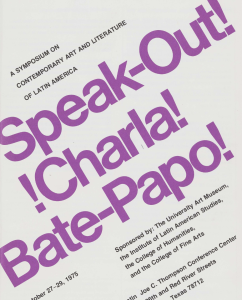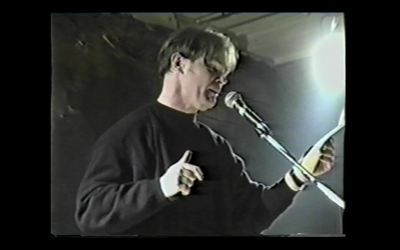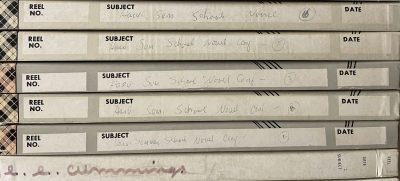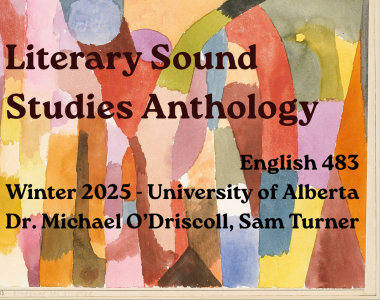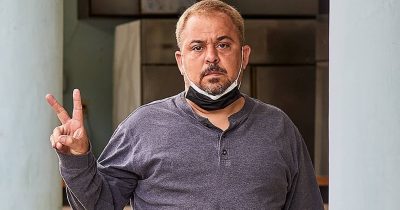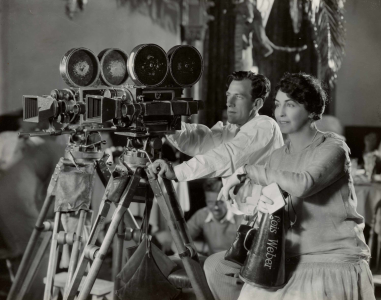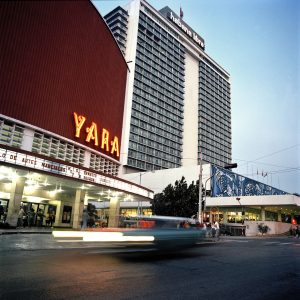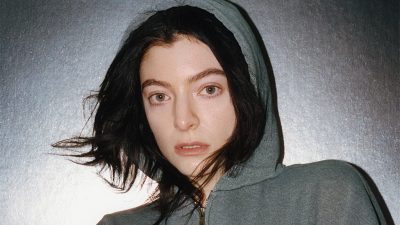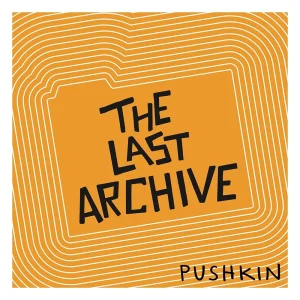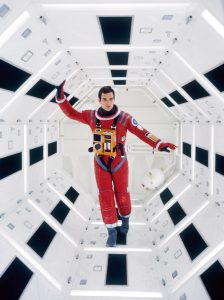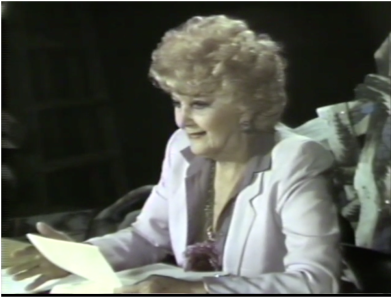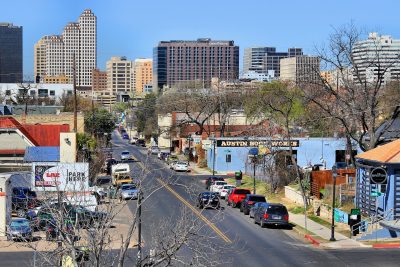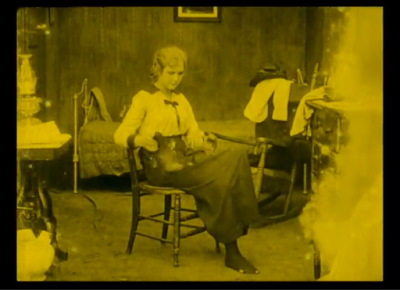Example Projects
See what the AV-Annotate community is creating
Speak-Out! Symposium Collection
The Speak Out! Symposium AVAnnotate site, developed at the LLILAS Benson Digital Scholarship Lab by Rebekah Ramos and Ash Catalan, presents a digital edition of the 1975 UT Austin symposium “Speak-Out! Charla! Bate-Papo! Contemporary Art and Literature in Latin America.” It features time-coded recordings of panels held over three days, in English, Spanish, and Portuguese, with bilingual transcripts for research and accessibility. The “Key Programs” section lists the major art and literature sessions (e.g., debates about whether a distinct Latin American art exists, the status of criticism, and joint review discussions), providing users with structured entry points into the full program. An especially helpful tool is the tag index, which allows you to trace people and themes across sessions.
Enough Said Reading Series
The “Enough Said Reading Series” is an AVAnnotate project by SpokenWeb that provides a digital edition of Montreal spoken-word events from 1994–1996. It features individual event pages (with performer line-ups and open-mic details), compilation reels, and an oral-history interview, along with commentary from recent community “watch parties.” What’s especially interesting is the 2025 watch-party model: original participants and organizers reconvene (hosted from Concordia’s AMPLab) to generate new annotations and reflections that add context to the historical recordings. Together, the structured listings, compilations, and annotations make the collection a valuable research tool for tracing networks, programming trends, and performance practices across the series over time.
Harvard 1953 Summer Conference on “The Contemporary Novel”
The “Harvard 1953 Summer Conference on the Contemporary Novel” AVAnnotate project, created by Professor Tanya Clement, is a digital collection of audio recordings and transcripts from the “The Contemporary Novel” conference held at Harvard University in 1953. The site offers annotated, time-stamped sessions featuring writers, critics, and editors such as Ralph Ellison, Georges Simenon, Stanley Hyman, and Frank O’Connor, making rare archival audio accessible and searchable. Through detailed annotations, the project sheds light on how mid-twentieth-century authors and scholars debated the purpose of fiction, narrative experimentation, and the cultural responsibilities of the novelist. What makes this project especially valuable is its ability to turn static archival materials into an interactive scholarly resource, providing new insights into the intellectual and artistic networks that shaped postwar literary modernism.
Literary Sound Studies Anthology: English 483, University of Alberta
“Literary Sound Studies: English 483 Class Anthology” is a student-created AVAnnotate project in collaboration with Sam Turner that compiles course projects into a public anthology. It focuses on how literature is performed and heard, using time-coded annotations to analyze voice, rhythm, silence, and audience in recordings of poems and performances. The variety is striking: students explore spoken-word (Sarah Kay & Phil Kaye), contemporary popular music (Taylor Swift’s “Seven”), modern and postwar poetry (Maya Angelou, Audre Lorde, Allen Ginsberg, Wilfred Owen), Indigenous and experimental work (Louise Bernice Halfe, Charles Bernstein), diasporic and sound-poetry pieces (Suheir Hammad, Michael Basinski), and studies of dysfluency (JJJJerome Ellis). What’s most compelling is how the interface’s filters and timestamped notes promote close listening as a collaborative scholarly practice—making technical features like caesura, timbre, pitch, and audience sound clear and accessible to a general, knowledgeable audience.
Lester Hamlet in Depth
The project was created by Jack Riordan and focuses on the work of Lester Hamlet, the distinguished and influential Cuban filmmaker. Offering bilingual content (English and Spanish), the project explores Hamlet’s poetry, archival materials, and cultural contexts. It presents a richly annotated digital edition of Hamlet’s poems alongside historical documents and interactive commentary, allowing readers to trace thematic, linguistic, and visual currents across texts. What makes the project especially interesting is its integration of literary scholarship with responsive visualization—offering side-by-side translations, audio recordings, and archival scans to deepen engagement with Hamlet’s bilingual creative world. The bilingual framework and layering of media help bridge academic and public audiences, making the poetry accessible and dynamically situated within broader histories of language, place, and identity.
The Lonely Villa (1909) & Suspense (1913)
This is a project created by Jack Riordan that explores two canonical early-cinema films side by side. Clement introduces viewers to Lois Weber, a pioneering silent film-era director, and contrasts her film Suspense (1913) with D. W. Griffith’s The Lonely Villa (1909), situating both within the “panic room” motif. What’s especially interesting is the close attention to technique: the annotations highlight Weber’s innovations, such as the three-way split screen, over-the-head framing, mirror shots, and dynamic in-car camera work, set against Griffith’s more proscenium-style staging. The site’s structured tags and filters make it easy for a general—but film-literate—audience to trace themes such as cinematography, narrative structure, and titles across both films.
Cuba en Pantalla
The project “Cuba en Pantalla” was created by Jack Riordan and draws on his experience taking the “Curso de Cine Cubano” at the Instituto Cubano del Arte e Industria Cinematográficos (ICAIC) in the fall of 2019. The project explores Cuban history, identity, and social imaginaries through a curated selection of films spanning from the 1960s to the 2010s, accompanied by brief essays on Cuban cinema’s cultural and political roles and a reflection on the crisis in film preservation in Cuba. What makes the project particularly compelling is its combination of historical narrative with filmic imagery, offering a layered view of Cuba’s revolution, society, and memory through both documentary and fictional cinema.
The Evolution of Lorde
This project by Leiah Bodden traces the artistic development of the New Zealand singer-songwriter Lorde through a curated selection of audiovisual materials that include music videos, performances, and interviews. The annotations highlight the evolution of her style, themes, and public persona across her career, moving from the minimalist detachment of Pure Heroine to the emotional and aesthetic richness of Melodrama and the introspective calm of Solar Power. Each annotation set categorizes observations of structure, context, impact, and literary devices, offering a layered analysis of her creative output. Taken together, the project demonstrates how Lorde’s music and visual presentation create a narrative of growth, transformation, and identity over time.
Annotating “The Last Archive”
Originally authored by Ali Gunnells and edited by Sam Turner, this project is the culmination of an independent study conducted under the supervision of Dr. Tanya Clement during the summer of 2022. The project explores how archival rhetorics are employed in contemporary podcasting through an analysis of Jill Lepore’s podcast The Last Archive. In the pages of this AVAnnotate project, you will find annotations of the first four episodes of The Last Archive Season 1, which were completed using Audacity.
Auterism
This project by Jack DeVry Riordan explores the theory and topic of Auteurism and some of the filmmakers who best represent it, including filmmakers Stanley Kubrick, Wes Anderson, Tomás Gutiérrez Alea, Andrei Tarkovsky, Akira Kurosawa, and more.
Latin American Press Review Radio Collection
As part of the Latin American Programs of the Longhorn Radio Network, the Latin American Press Review radio program covered all of Latin America and the Caribbean, airing from 1973 to 1974. Divided into two segments, each program began with a news segment that highlighted a variety of reports from across Latin America, while the second half consisted of interviews or discussions with a variety of groups and/or individuals. A diverse number of topics were covered, including human rights abuses, economic conditions, music, popular culture, and the history and politics of the region.
Originally processed in 2010, digital reformatting of analog reel-to-reel audiotapes is ongoing. The annotations cover the programs released between 1973 to 1974. The highlighted annotations are the countries and communities that stood out throughout the segments included within these programs.
Annotating Adler: Identity and Embodiment in the Stella Adler Collection
This project by Zoe Bursztajn-Illingworth contextualizes recently digitized video from the Stella Adler and Harold Clurman Collection at the Harry Ransom Center. The eleven digitized videos, provided to the public by The Ransom Center, show Adler teaching at the Stella Adler Studio of Acting between 1969 and 1980 as well as being interviewed by Bob Crane. These digitized videos are a small portion of over a thousand audiovisual items in the collection. We hope that these annotations and essays put in context these digitized audiovisual materials and serve as an entry point into research in the Stella Adler collection.
RHE 306 Anthology
This is an anthology of AVAnnotate projects developed for RHE 306: Rhetoric and Writing. For this project, students were asked to think about how arguments about gentrification function differently in digital spaces—through sound, image, and voice. Using AVAnnotate, they produced original audio or video compositions paired with annotations and a transcript that examine the rhetorical strategies at play.
Lois Weber’s Shoes
This comparison project by Luke Sumpter annotates Lois Weber’s 1916 silent film Shoes. In one of the annotation sets, the first contributor traces the film’s narrative through its use of intertitles to establish a timeline, pathos, dialogue, and its overall exegesis. The second set of annotations traces the film’s editing techniques, which in 1916, were perfecting their ability to capture time and space. Taken together, the project demonstrates the way in which film form creates story in the hands of a pioneering woman filmmaker.
Voices: Micro-editions of Readings by Marlatt, McClure, and Rukeyser
Edited by Tanya Clement, Emily Murphy, Karis Shearer, Trent Wintermeier, and Matthew Kilbane, the micro-editions gathered here include Michael McClure reading from his book Ghost Tantras; Muriel Rukeyser reading a poem-sequence that shares a title with her poetry collection The Speed of Darkness; and Daphne Marlatt reading from her first collection of poems leaf leaf/s (Black Sparrow Press, 1969) in 1969 and then later in 2019. It is a collection that shows an investment in the audition of context.
Radio Venceremos
In Vera Burrows’s AVAnnotate project “The Power and Reality of Radio During Revolution / El poder y la realidad de la radio durante revolución,” Burrows presents her research on a collection of civil war recordings from a Salvadoran rebel radio station, Radio Venceremos, to both anglophone and hispanophone audiences. She does so by creating two sets of annotations on the same audio events: one annotation set translates the transcripts of these Spanish recordings into English (useful for anglophone audiences) and the other presents contextualizing research on the violence of these recordings into Spanish (useful for hispanophone audiences). This project was originally built for AudiAnnotate, and was re-created with AVAnnotate by Jack D. Riordan.
Comparison Screen for Shoes
This comparison project by Luke Sumpter and Zoe Bursztajn-Illingworth showcases two different aspects of formal film analysis, editing and intertitle, within the 1916 silent film Shoes by Lois Weber.
Camille (1921): A Case for Annotating Film History
This digital edition by Janet Reinschmidt annotates the 1921 film Camille starring Rudolph Valentino and Alla Nazimova.
Zora Neale Hurston’s WPA Field Recordings (1939)
This digital edition by Tanya Clement transcribes and contextualizes recordings of the Harlem Renaissance writer and anthropologist Zora Neale Hurston doing fieldwork in Jacksonville, FL. Held by the Florida Memory Project, the Zora Neale Hurston’s WPA field recordings in Jacksonville, FL were made for the Library of Congress on June 18, 1939 with Herbert Halpert recording.
Digital Florilegium
This project is an interdisciplinary study by Luke Sumpter, an undergraduate student at UT Austin, of time in digital media. Sumpter annotates and discusses films by Denis Villeneuve, Derek Jarman, a radio play adaptation of The Glass Menagerie, and a recorded conversation between Carson McCullers and Tennessee Williams held at the Harry Ransom Center.
SpokenWeb Digital Anthology
Edited by Dr. Zoe Bursztajn-Illingworth and Dr. Tanya Clement at UT Austin, The SpokenWeb Digital Anthology exhibits annotated audio and video recordings from literary archives across Canada. The anthology presents original research written to contextualize and newly theorize these recorded readings, panels, videopoems, and classroom visits by authors such as Kathy Acker, Irving Layton, Dorothy Livesay, Kaie Kellough, Roy Kiyooka, Daphne Marlatt, Michael McClure, and Muriel Rukeyser.
Furious Flower Poetry Center Transcriptions
These transcripts of video recordings from the Furious Flower Collection at James Madison University in Harrisburg Virginia were created by Evan Sizemore. The recordings from Furious Flower document interviews and readings by major African American poets, among them Rita Dove, Yusef Komunyakaa, Sonia Sanchez, and Major Jackson, accompanied by contextualizing information about them.
Anne Sexton, Sweetbriar College, 1966
This an annotated recording featuring Anne Sexton reading at Sweetbriar in 1966. The recording is held as part of the Anne Sexton Papers at the Harry Ransom Center at the University of Texas, Austin. The annotations were created by Dr. Tanya Clement.
